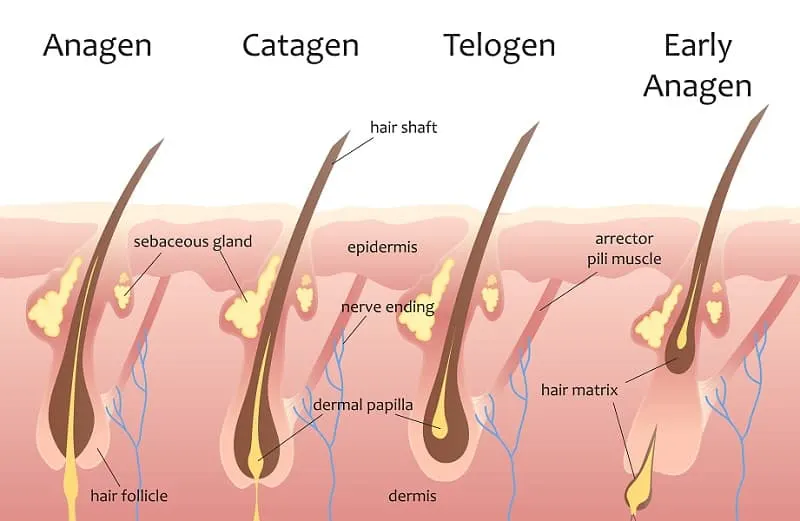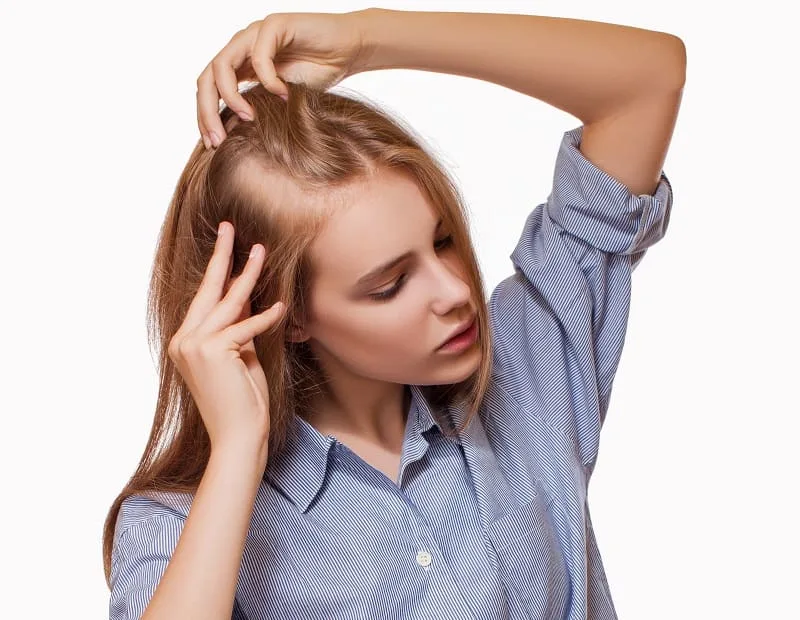Take a deep breath and relax. If hair strands that have fallen from your scalp have white bulbs on the ends, it doesn’t necessarily mean you’re permanently losing your hair.
Contrary to popular belief, a white bulb is not the hair root; it’s the part of the hair strand closest to the root, and it’s made up of sebum and other organic matter.
When you see a white bulb, it means a hair was just lost at the root level during the telogen hair phase (more about that later), but not that the root itself was lost.
What Does the White Bulb Mean?
The best way to understand the significance of a white hair bulb is by learning a bit about the hair growth cycle.
The Four Phases of Hair Growth:

Anagen – This is the active phase when the cells in the root of the hair are dividing rapidly. It typically lasts from 2 to 6 years and determines the hair’s length. About 80% of hair is in the anagen phase at any one time.
Catagen – This 2 to 4-week cycle is also known as the transition phase when active hair growth stops and the follicle itself pushes through from the papilla.
Telogen – The telogen phase is a rest period for hair cells. Underneath the skin’s surface (scalp), a new anagen hair is developing and will soon push the telogen hair, with the white bulb, from the follicle.
Early Anagen/Exogen – This is the stage when a telogen hair actually falls out as the newly-formed anagen hairs push through the follicle. This is the stage where, in a normal cycle, 50-100 hairs are lost every day.
Not all the hair growth cycle phases are happening at the same time. Each individual hair undergoes the cycle in its own timing, but generally speaking, at any point, 75-80% of the hair on your head will be in the anagen phase, and the other 20% will be in the telogen phase.
That’s an important fact to remember because it means that, for most people, losing hair happens at a consistent rate (unless you’re dealing with permanent hair loss). It also means that more new hair is growing under normal circumstances than the amount that’s falling out.
Telogen Effluvium
Telogen Effluvium is a condition characterized by excessive hair loss during the telogen phase. The word “effluvium” literally means “outflow,” and that’s exactly what’s happening to your hair when you’re losing it!
An abundance of hairs on your head are prematurely entering the telogen phase and falling out with the white bulb attached. The result is an overall thinning of the hair.
Medical researchers are still learning more about telogen effluvium. Still, at this time, it’s believed that the condition is caused by hormonal changes, such as those that occur during pregnancy or when giving birth, as well as certain illnesses, medicines, or treatments.
Emotional stress can also trigger the condition, as can nutritional deficiencies or a shock to the system due to injuries or surgery.
If you’re dealing with any of the above circumstances and noticing that you’re losing a lot of hair with white bulbs attached, you can take comfort in knowing the condition is likely temporary (especially in cases where the mitigating factors can be remedied).
On the flip side, if you’re not experiencing any of these issues, it’s more probable that the hair you’re losing with white bulbs on the end is a sign of permanent hair loss.
What Can I Do to Avoid Excessive Hair with White Bulbs Falling Out?

- Keep the scalp and hair follicles clean and healthy. Use natural hair products that don’t contain a lot of chemicals. Your goal is to strengthen and fortify the hair follicles and roots with quality natural substances.
- Essential oils such as oregano, pumpkin seed, and tea tree oil are fantastic choices, but dilute them with carrier oils like coconut, olive, or avocado. You can also add them to natural shampoos, conditioners, hair creams, mousses, and gels.
- When choosing a shampoo, don’t be impressed by suds; instead, select the natural and chemical-free ones. In addition to traditional shampoos, products such as apple cider vinegar and baking soda can help keep the scalp healthy and prevent hair with white bulbs from falling out.
- Block or lower the levels of DHT hormones, which, when present on the scalp, can cause premature thinning and hair loss.
- If telogen effluvium is nutrition-based, it can be reversed by improving your eating habits. Simple actions like reducing and avoiding sugar, greasy food, sodas, and dairy products can help. In addition, be sure to include a wide variety of colorful vegetables and lean meats in your diet.
- To slow down stress-based telogen effluvium, learn how to relax in meaningful ways, for example, with yoga, tai chi, deep breathing, massage, and prayer.
Does hair with a white bulb grow back?
Yes, hair with a white bulb will absolutely grow back. While some people worry that finding shed hair with white bulbs means it has fallen out at the roots and the follicle itself is dead. Do not worry: this is not the case.
Your hair bulbs are just one part of the follicle lining, and it is entirely natural for that lining to shed periodically and be replaced by a new lining, similar to skin cells being shed and regrown.
Does the White Bulb Have Anything to Do with Hair Loss?
Because it’s normal for a white bulb to be present on the end of a telogen hair shaft, it’s not automatically a sign of problematic hair loss.
A certain amount of daily hair loss is normal and should be expected, and those hairs will often have a white bulb. However, when the rate of hair loss exceeds the normal pace, you should consider the possibility that you’re beginning to lose your hair.
I’m Losing Hair, How Do I Know if the White Bulb Isn’t the Indicator?
Check for these –
- Excessive shedding. Are you finding a lot of hair on your pillows, car seats, sofas, office chairs, clothing, or on towels, or in the shower drain?
- Flaky, itchy scalp. An unhealthy, dry scalp isn’t good for combatting hair loss.
- Thin, wispy hair. Are you noticing a widow’s peak forming or a circular area on the rear crown of your head?
- Genetic predisposition towards “Telogen Effluvium.”
Losing hair with the white hair bulb at the end is perfectly normal. As mentioned, most people lose from 50 to 100 hairs every day. When more than that is shed, you might have a problem.
But even if you’re losing hair, don’t lose hope! A holistic, multi-faceted program can help to slow down or eliminate excessive hair loss forever.
FAQs
The bulbs of your hair are beneath your skin at the base of your hair follicles. The bulbs are where the hair shaft cells grow and where the hormones that control hair growth are delivered.
The bulbs are also the location of the nerve endings that react when your hair is moved, allowing you to feel it.
White hair bulbs are deposits of the protein keratin, which your skin, hair, and nails are made of, around the roots of your hair.
Their white coloring comes from their lack of melanin or pigmentation.
White hair bulbs indicate that the hair had already stopped growing by the time it fell out.
If the hair has black bulbs on its ends, the hair likely lacked a keratin deposit and was still in the process of growing when it fell or was pulled out.
A hair falling out with a white bulb means it reached the final stage of hair growth (the telogen phase) and shed.
It grew out completely, reached the end of its life cycle, and was pushed out of the follicle by new hair growth.
